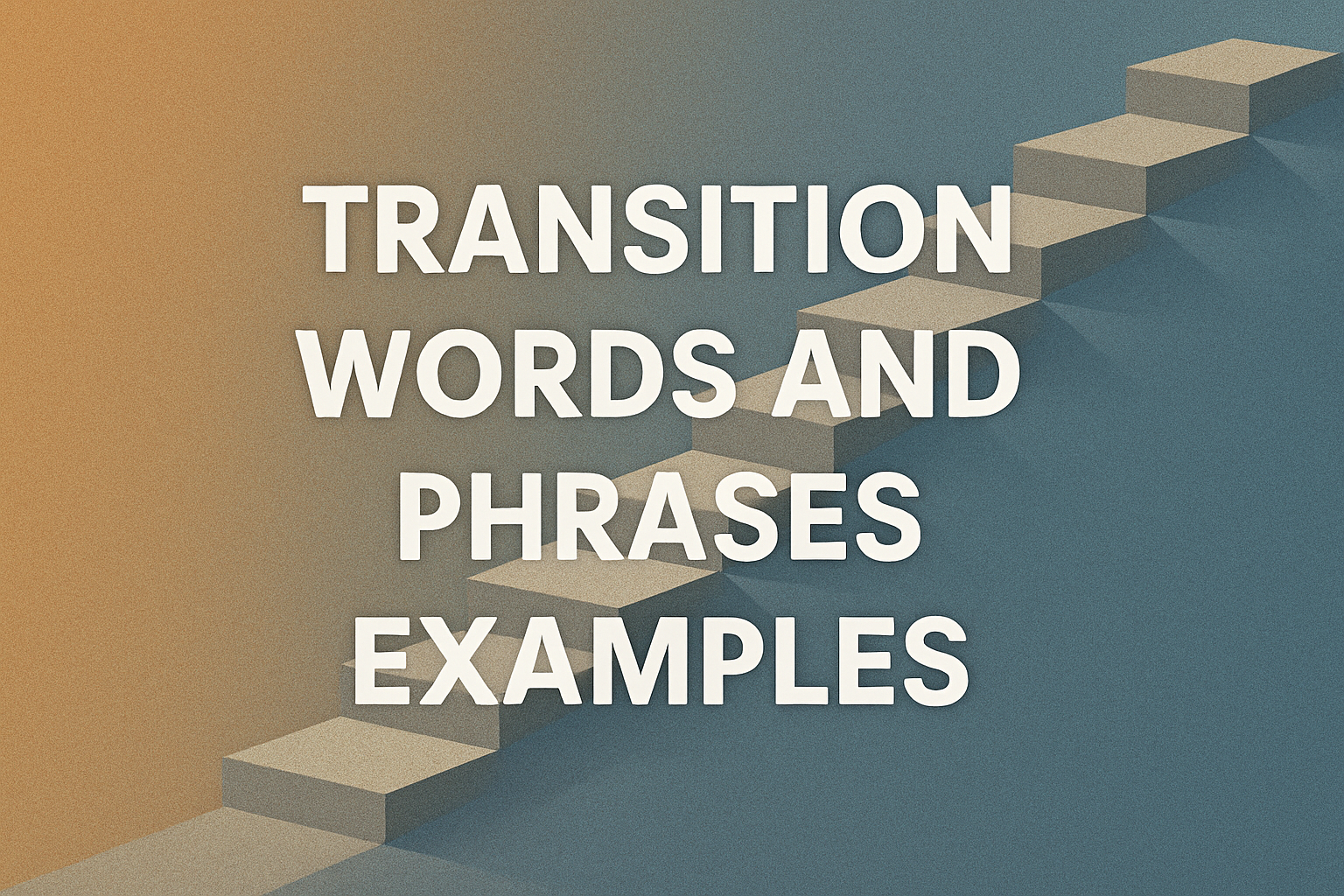So you’re writing something—a blog post, an essay, maybe even a speech—and it just feels… choppy. Like a bunch of ideas thrown together without a rhythm. That’s where transition words come in. Think of them like bridges that connect your thoughts, making everything flow smoothly. Without these little connectors, even the smartest arguments can feel scattered. The right transition words help readers follow along, and they guide them from point A to point B without confusion. Let’s walk through examples, uses, and tips so you never feel stuck again.
What Are Transition Words and Why Use Them?
Transition words and phrases are the glue in your writing. They show how ideas relate to one another—like cause and effect, comparison, or adding more info. Without them, your writing can feel like a list of thoughts instead of a complete conversation.
These words do all kinds of jobs. Some show time, others compare, some add, and a few wrap things up. For example, “however” signals contrast, while “as a result” shows cause and effect. Using them is like putting on turn signals when you drive—it tells your reader where you’re headed.
List of Transition Words for Everyday Writing
Here’s a go-to list you can keep handy. These transition words can help in essays, blog posts, or any kind of writing.
1. Addition Transitions
Use these to add more information or emphasize continuation.
Transition Words:
Also
Furthermore
Moreover
In addition
Not only that
Examples in Sentences:
I love playing tennis. Also, I’ve recently picked up squash.
He’s a talented speaker. Furthermore, he writes compelling articles.
She arrived early. Moreover, she brought coffee for everyone.
We visited the museum. In addition, we took a boat tour.
The product is affordable. Not only that, it’s eco-friendly.
2. Contrast Transitions
Use these to show a difference, contradiction, or change in direction.
Transition Words:
However
On the other hand
Nevertheless
Still
Yet
Examples in Sentences:
He studied all night. However, he didn’t pass the exam.
I love road trips. On the other hand, my brother prefers flying.
She was exhausted. Nevertheless, she kept working until midnight.
We’ve told him several times. Still, he forgets.
It’s a simple idea. Yet, few people understand it.
3. Cause and Effect Transitions
Use these when one thing leads to another.
Transition Words:
Therefore
As a result
Consequently
Because of this
Hence
Examples in Sentences:
The store was closed. Therefore, we went somewhere else.
He skipped breakfast. As a result, he felt dizzy by noon.
She didn’t train properly. Consequently, she lost the match.
He forgot his umbrella. Because of this, he got soaked.
The roads were icy. Hence, the delay in delivery.
4. Time/Sequence Transitions
Use these to show the order or timing of ideas.
Transition Words:
First
Then
After that
Meanwhile
Eventually
Examples in Sentences:
First, we gathered all the materials.
Then, we began assembling the structure.
After that, we tested everything twice.
Meanwhile, the support team prepared the backup plan.
Eventually, we launched the final version.
5. Emphasis Transitions
Use these to highlight important information or stress a point.
Transition Words:
In fact
Indeed
Clearly
Without a doubt
Especially
Examples in Sentences:
In fact, this is the third time he’s won.
She’s a great leader. Indeed, people trust her without question.
Clearly, something went wrong with the update.
That was, without a doubt, her best performance.
He’s skilled at many things, especially problem-solving.
6. Comparison Transitions
Use these to show similarities between ideas.
Transition Words:
Similarly
Likewise
Just as
In the same way
Equally
Examples in Sentences:
She loves classical music. Similarly, her brother enjoys opera.
He’s very focused. Likewise, his team follows his lead.
Just as we expected, the results were excellent.
In the same way, good habits lead to better performance.
She handled the issue equally well under pressure.
7. Clarification Transitions
Use these to explain something more clearly or restate it.
Transition Words:
In other words
That is to say
To clarify
To put it another way
Namely
Examples in Sentences:
He’s introverted. In other words, he needs quiet time to recharge.
The budget was cut. That is to say, fewer resources are available.
To clarify, you need to submit the form today.
We need consistent effort. To put it another way, don’t give up halfway.
Two departments were affected: namely, marketing and sales.
8. Conclusion/Summary Transitions
Use these to wrap things up or summarize a point.
Transition Words:
In summary
To sum up
Overall
All in all
Finally
Examples in Sentences:
In summary, the event was a major success.
To sum up, we’ve completed all project milestones.
Overall, everyone was happy with the outcome.
All in all, the experience was unforgettable.
Finally, we submitted the final report by the deadline.
List of Transition Words for Everyday Writing
| Category | Transition Words |
|---|---|
| Addition | Also, Furthermore, Moreover, In addition, Too, As well, Plus, Not only that, Additionally, Again |
| Contrast | However, On the other hand, Nevertheless, Still, Yet, Although, Though, Conversely, Even so, Whereas |
| Cause and Effect | Therefore, As a result, Because of this, Consequently, Hence, Thus, Due to, For this reason, Since, Accordingly |
| Time/Sequence | First, Then, Afterward, Next, Meanwhile, Eventually, Later, At last, Finally, Subsequently |
| Emphasis | Indeed, In fact, Clearly, Without a doubt, Especially, Of course, Absolutely, Definitely, Unquestionably, Surely |
| Comparison | Similarly, Likewise, Just as, In the same way, Equally, Correspondingly, In like manner, As well, Analogously, As if |
| Clarification | In other words, That is to say, To clarify, To put it another way, Namely, Simply put, Meaning, To explain, To rephrase, Specifically |
| Conclusion/Summary | In summary, To sum up, Overall, All in all, Finally, To conclude, In short, In closing, At last, To end with |
Quick Tips for Better Transitions
Still finding your writing a bit choppy? Don’t worry—it happens to the best of us. Even when your ideas are solid, poor transitions can make everything feel disjointed. The good news is, with a few smart habits, you can smooth things out quickly. Here are some simple, practical tips to help your writing flow better by using transition words the right way.
Read aloud: If your writing sounds too jumpy, try adding a transition word. Reading out loud makes it easier to notice where the flow breaks down or where your thoughts feel disconnected.
Use variety: Don’t keep repeating the same transition word. Instead of using “however” in every paragraph, try mixing in “yet,” “still,” or “on the other hand.” A little variety makes your writing feel more natural and keeps readers engaged.
Plan ahead: Think about how each paragraph connects to the next. Good transitions don’t just happen—they’re part of your structure. Knowing where your argument or story is going helps you pick smoother connecting words.
Keep it simple: You don’t always need a fancy phrase. Sometimes a basic word like “then” or “also” does the job just fine. Don’t overthink it—clarity beats complexity every time.
Revise intentionally: Once your first draft is done, go back and check for rough shifts between ideas. Ask yourself: Would a transition word help here? If so, add it to guide your reader gently from one thought to the next.




